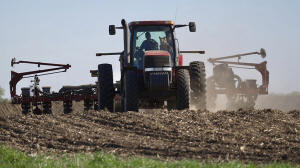Farmers weigh Trump's trade war like they watch the weather, waiting to
see how things go
[May 14, 2025] By
STEVE KARNOWSKI and KRISTIN M. HALL
WAVERLY, Minn. (AP) — Minnesota farmer Dan Glessing isn’t ready to get
too upset over President Donald Trump’s trade wars.
Farm country voted heavily for Trump last November. Now Glessing and
many other farmers are taking a wait-and-see attitude toward the
Republican president's disputes with China and other international
markets.
China normally would buy about one row out of every four of the
Minnesota soybean crop and took in nearly $13 billion worth of soybeans
from the U.S. as a whole last year. More than half of U.S. soybeans are
exported internationally, with roughly half of those going to China, so
it's a critical market.
Trump last month raised U.S. tariffs on products from China to 145%, and
China retaliated with 125%. But Monday's announcement of a 90-day truce
between the two countries backed up the reluctance of many farmers to
hit the panic button.
More good news came in an updated forecast from the U.S. Department of
Agriculture on Monday that projected higher corn exports and only
slightly lower corn prices. The report also predicted somewhat lower
soybean exports but higher domestic consumption, resulting in higher
prices. Soybean futures surged.
After he finished planting his soybean crop on Monday, Glessing said he
was excited by the news and hopes to see more progress. But he said he
wasn't really surprised.

Tariffs, weather and other uncertainty
On a bright, sunny day last week, as he began planting soybeans,
Glessing said tariffs were only one of the things he's worried about —
and not necessarily the biggest. Farming, after all, is an enterprise
built on loose soil, the whims of weather and other uncontrollable
factors.
“Am I concerned about tariffs? Yeah. I mean, there’s uncertainty that
comes with that," Glessing said. "Is that the number one driving factor
in these poor commodity prices the last two years? No.”
As he steered his 25-year-old Case IH tractor over a gently rolling
field near the town of Waverly, he towed a planter that inserted his
seeds through the stubble of last year’s corn crop. As he laid down the
long rows, he rumbled past a pond where wild swans paddled about.
Riding shotgun was Georgie the Corgi, who alternated between roaming
around his cab and half-dozing at his feet.
Perhaps more skeptical than Glessing is Matt Griggs, one of many soybean
farmers in Tennessee paying close attention to the trade war. On Monday,
he said the ripple effects on farmers might still be coming.
“We’re only on a 90-day pause,” Griggs said. “Who knows what is going to
come after that?”
Joe Janzen, an agricultural economist at the University of Illinois,
said the commodity markets have largely shaken off the initial shock of
the trade war, including Trumps’ declaration of April 2 as “Liberation
Day,” when he announced stiff worldwide tariffs.
“Our markets have largely rebounded and are back where we were around
April Second,” Janzen said. “Tariffs have not had a major impact on
prices yet.”

Even something that might seem like good news — ideal planting
conditions across much of the Midwest — has its downside. The potential
for bigger crops sent prices downward, Glessing noted. High interest
rates, seed and fertilizer costs pose additional challenges.
“There’s so many other factors besides just tariffs and my market
price,” Glessing said.
Looking for signs of progress
But Glessing said he was encouraged by that morning’s news of a trade
deal with the United Kingdom, and said he hopes the current uncertainty
in talks with China and other countries ultimately leads to better trade
deals going forward.
[to top of second column] |

Soybeans are planted on Thursday, May 8, 2025 near Waverly, Minn.
(AP Photo/Mark Vancleave)
 Glessing had finished planting his
corn the day before on the other half of a field that he rents from
his father’s cousin, split between 45 acres of corn and 45 acres of
beans. It's at the farm where his grandfather grew up, and it's part
of the approximately 700 acres he plants on average. He locked in
those planting decisions months earlier as he made deals for seeds,
fertilizer and other supplies.
Back on his “home farm” closer to Waverly — where his late
grandfather’s house, made of local brick, still stands and a
cacophony of house sparrow songs filled the air — Glessing was
pleased to spot the first signs of corn he had planted there about
10 days earlier poking above the soil.
Waverly is about an hour west of Minneapolis. Its most famous
resident was Democratic former Vice President Hubert Humphrey. It’s
in the congressional district represented by Republican House
Majority Whip Tom Emmer.
Glessing’s post as president of the Minnesota Farm Bureau puts him
in close touch with other influential politicians, too. He and his
wife, Seena, were Democratic Sen. Amy Klobuchar’s guests at the
Capitol for Trump’s inauguration in January. Glessing declined to
say who he voted for.
The Glessings have three kids, milk about 75 dairy cows, and grow
corn, soybeans and alfalfa on a combination of parcels they own or
rent. He uses the alfalfa and corn primarily to feed his cows. He
sells his soybeans to a processing plant in Mankato, where some of
them become soybean meal he adds to his animal feed. The milk from
his cows goes to a co-op cheese plant in Litchfield that sells
internationally.
Because Glessing has local buyers locked in and doesn’t directly
export his crops, he's partially cushioned from the volatility of
world markets. But he’s quick to point out that everything in the
agricultural economy is interconnected.

Lessons learned during Trump's first trade war
On his farm near Humboldt, Tennessee, roughly midway between Memphis
and Nashville, Griggs weathered the 2018 trade war during Trump’s
first term and said he feels more prepared this time around.
“Back in 2018, prices were about the same as what they are now, and
due to the trade war with China, prices dropped around 15%,” he
said. “They dropped significantly lower, and they dropped in a
hurry, and due to that, we lost a lot of demand from China.”
Griggs said exports to China never fully rebounded. But he doesn't
think the impact of the current dispute will be nearly as drastic.
Griggs — who raises approximately 1,600 acres of cotton, corn,
soybeans and wheat — said tariffs were just one consideration as he
planned out this year’s crops. Growing a variety of crops helps him
minimize the risk that comes with weather, volatile prices, and now
the prospect of a trade war.
Griggs said he’s going to be watching for opportunities to sell when
market volatility causes upticks in prices.
“The main thing I learned in 2018 was that if you do have a price
period where prices have risen some, go ahead and take advantage of
it instead of waiting for it to go higher,” said Griggs. “Because
when it comes to the tariffs and everything, the markets can be very
unpredictable. So my lesson learned was, ‘Don’t hold out for a home
run, be satisfied with a double.’”
He said a temporary subsidy called the Market Facilitation Program
helped soybean farmers withstand some of the losses last time could
help if something similar is revived this year. But he said no
farmer wants to make a living off government subsidies.
“We just want fair access to markets,” Griggs said. “And a fair
price for the products we produce.”
___
AP videographer Kristin M. Hall reported from Humboldt, Tennessee.
AP videographer Mark Vancleave also contributed from Waverly.
All contents © copyright 2025 Associated Press. All rights reserved |